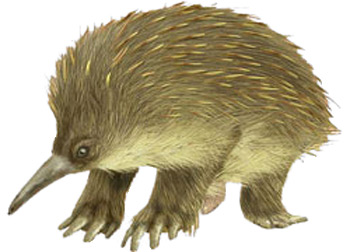
|
Search JoyZine with Google Site Search! |
Megalibgwilia ramsayi
Megalibgwilia was first described from a broken left humerus by Richard Owen when he identified M. ramsayi in 1884. Complete skulls and postcranial fossils have since been described. A second species, M. robusta, was described in 1896 by Australian paleontologist William Sutherland Dun. M. robusta is the oldest known echidna and the only known Miocene species. Although they are sometimes commonly referred to as giant echidnas, Megalibgwilia species are thought to have been similar in size to the contemporary western long-beaked echidna, but with slightly longer forearms. The robust construction of their forelimbs indicated that they were powerful burrowers and probably dug out insect larvae. Their beaks would have been able to handle insects and larvae, not just ants, as with modern echidnas. They were smaller than a large species known from fossils in Australia, Zaglossus hacketti. M. ramsayi fossils have been found in deposits across mainland Australia and on Tasmania. M. robusta has only been found in New South Wales. Megalibgwilia was probably an insect-eater, like the short-beaked echidna, rather than a worm-eater like members of Zaglossus. Dun (1895) described a new species of tachyglossid that he named Echidna robusta. Murray (1978a) placed E. robusta in Zaglossus so that it became known as Z. robusta. However, he almost immediately (Murray, 1978b) synonymized this species with Echidna ramsayi (Owen, 1884) when he had examined extra post-cranial material, but simultaneously transferred E. ramsayi to Zaglossus, the genus to which he had originally assigned the junior Z. robusta in the first place. Z. ramsayi, as it became known, was again transferred to a new genus erected by (Griffiths et al. 1991): Megalibgwilia. No further taxonomic changes have taken place. |
